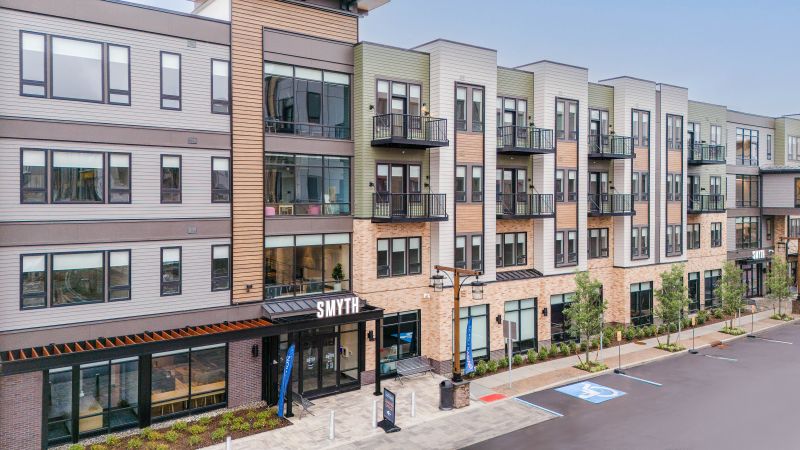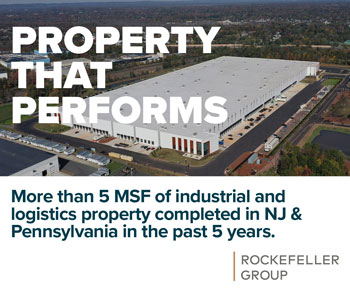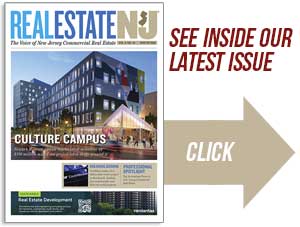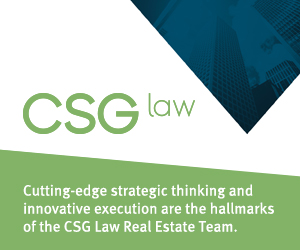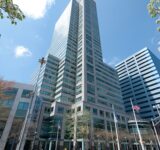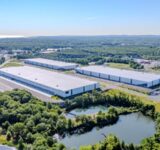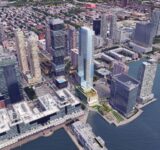The District at 15fifteen in Parsippany is transforming the former Intel corporate campus on Route 10 into a 498-unit apartment complex with retail amenities. — File photo/Courtesy: Stanbery Development Group
By Jeffrey L. Heller, SIOR
Principal and Executive Director
Avison Young
Introduction
Empty office buildings and half-vacant corporate campuses have become a familiar sight in New Jersey. In the wake of the pandemic, and the rise of remote and hybrid work, companies are using less space and leaving behind millions of square feet of surplus offices. At the same time, there’s a pressing need for housing and modern industrial facilities. It’s no surprise then that developers in the Garden State are increasingly turning these underused offices into multifamily residences and warehouses. This white paper explores the scale and characteristics of New Jersey’s office conversion boom focusing on the transformation of offices into residential and industrial uses as well as the impact it will have on developers, investors and occupiers.
New Jersey has seen a dramatic shift in its office market fundamentals overall. Office vacancy rates are approximately 17 percent in northern and central New Jersey as tenants consolidate and relocate to highly amenitized buildings with financially stable owners. Statewide, elevated vacancies have pushed owners to reposition obsolete properties, often by demolition and redevelopment into alternative uses. In fact, over the past five years New Jersey has demolished or redeveloped more office space than it has built new, leading to a net decline in office inventory by 9.6 percent. This reflects a broader national trend: Since the mid-1990s, it is estimated that more than 150 million square feet of U.S. offices have been converted to other uses, with activity peaking in the last few years. The following sections delve into New Jersey’s conversion projects in detail, using the latest data on redevelopment projects across the state.

The scale of office redevelopment in New Jersey
New Jersey’s office conversion pipeline is substantial. According to Jordan Katz, Market Intelligence Analyst, there are 141 identified office conversion projects across the state that have been completed, are under construction or are proposed as of August 2025. Of these, 109 projects have either finished conversion or are actively under construction, while another 32 are in proposal stages. To put this in perspective, roughly 22.1 million square feet (msf) of former office space is being removed from the market to make way for new uses. This 22.1 msf represents 9.6 percent of the total office inventory.
Moreover, the pace of conversions has accelerated sharply in the past few years. For much of the late 2010s, New Jersey saw only a handful of office redevelopments per year. However, as remote work patterns solidified post-pandemic, the trend kicked into high gear. By 2022, there was an explosion of conversion projects initiated, and this increased activity has continued through 2025. The count of redevelopments spiked in 2022, indicating a post-pandemic surge. The year 2022 saw 35 office properties begin conversion by demolition or construction start, dwarfing prior years. While 2023 showed a slight dip from that peak, it still far exceeded pre-2020 levels. Currently, there are at least 27 projects under construction, with more slated for the near future. This recent wave confirms that repurposing office assets was not an anomaly but an ongoing movement in the state’s real estate market. Developers increasingly recognize that many aging offices will never return to full occupancy and are opting to transform them into properties that meet today’s demands.
What offices are being converted into
When an office building can no longer attract tenants, what should it become instead? In New Jersey, the clear preference has been residential or industrial reuse. These two categories account for the vast majority of conversions:
- Multifamily residential: By far the largest single category, 49 percent of all tracked projects are converting offices into apartments (often upscale rentals). Developers are seizing the opportunity to address housing demand by creating new multifamily communities on well-located office sites.
- Industrial/logistics: The second major category, about 30 percent of projects, involves conversions to industrial use — typically modern warehouses and distribution centers that serve the booming ecommerce and logistics sector.
Together, these two uses make up roughly four out of five office conversions in New Jersey. The remaining projects are split among other uses such as hospitality (hotels), self-storage facilities, medical or life science centers, educational facilities and a few unique projects (for example, one former office site became a specialty sports training complex for the New York Red Bulls).
This breakdown underscores that the demand for “bedrooms and big boxes” are the top priorities driving office redevelopment. New Jersey has a housing affordability crunch and is also a prime location for distribution facilities based upon the access to the Port of New York and New Jersey, which serves the whole tristate region and roughly 40 percent of the U.S. population within a 500-mile radius, or one day’s drive by tractor-trailer.
Residential conversions: Creating new homes
The push to convert offices to multifamily housing aligns with both economic need and public policy goals. The multifamily market in New Jersey continues to outperform most of the nation. Notably, some of the largest conversion projects are multifamily. For instance, The District at 15fifteen in Parsippany (Morris County) is transforming the former Intel corporate campus into a 498-unit apartment complex with retail amenities.
In Bergen County, The S. Hekemian Group is proposing another 305 multifamily units on the site of a 726,738-square-foot office property at 400 Parsons Pond Drive in Franklin Lakes. Construction is slated to begin in October of this year.
The former Mondelez headquarters in East Hanover has been demolished with approximately 500 multi-units to be built.
These projects illustrate how obsolete offices can be reimagined as much-needed housing. Our data indicates that at least 5,500 new apartment units have come from office-to-residential conversions in the past five years. Each conversion helps chip away at the housing shortage while revitalizing sites that might otherwise sit vacant. But will this multifamily development bubble burst?
Industrial conversions: Logistics takes the lead
The other major path for office conversions in New Jersey is redevelopment into industrial space. New Jersey’s strategic location for distribution has made industrial real estate extremely active. Modern warehouse vacancies are low and rents are high, so developers are eager to find new sites — even if it means tearing down outdated offices. Roughly a third of New Jersey’s office conversions result in distribution centers, warehouses or flex industrial buildings. Statewide, our data show 40 industrial conversion projects, including both large campus redevelopments and smaller infill sites. While these projects are fewer in number than residential conversions, they often involve larger footprints (the total square footage of offices converted for industrial use is nearly as high as that for residential in New Jersey). Developers and investors favor industrial reuse when the location suits it, because warehouse projects can be less complex to build and tenant demand for modern logistics space remains robust.
Other new uses
Aside from housing and warehouses, about 20 percent of New Jersey’s office conversions have taken different routes. Other conversions include self-storage centers, educational campuses, data centers and mixed-use retail projects. These examples show that creative reuse is possible depending on a building’s characteristics, lot and location. However, such cases are relatively infrequent compared to multifamily and industrial.
Where conversion projects are happening
Office-to-residential and industrial projects are not evenly spread throughout New Jersey — they tend to cluster in certain counties and submarkets. Northern New Jersey, especially Morris and Bergen counties, leads the state in these redevelopments. Parsippany leads the way with 29 of the state’s 141 projects. Morris County, with 47 projects, has the highest concentration among counties and exactly one-third of all identified conversion projects, followed by Bergen (26) and Essex (20). These three northern counties account for 65.9 percent of all conversions.
This is consistent with the large number of office parks in Morris County that have struggled with vacancy — many along the I-80 and I-287 corridors. It’s also reflected in unit counts: Roughly one-third of all new multifamily units from New Jersey office conversions have been built in Morris County, indicating its prominence in residential reuse. Bergen County, with 25 projects, ranks second. Essex County (20 projects) is the third major locale — this includes Newark and surrounding suburbs such as Roseland and Livingston, where some older offices have been converted to apartments or other uses. Middlesex (13 projects), Somerset (8), Union (8) and Mercer (8) also see notable activity. Generally, in suburban office corridors like Route 1 (Mercer/Middlesex), the Parsippany area (Morris), and the Bridgewater/I-78 area (Somerset).
In contrast, much of southern New Jersey has seen few office conversions to date — for example, counties like Atlantic, Ocean, Camden and others are not represented in the dataset. South Jersey’s office inventory is smaller and less overbuilt than North Jersey’s, while demand for alternative uses is more concentrated in the northern part of the state. Over time, if office vacancies persist broadly, we may see the trend expand geographically. For now, the “hot spots” are North and Central Jersey towns that boomed with office development in past decades and now are ripe for repurposing.
The developer’s perspective: Challenges and opportunities
Converting an office into a new use is a complex undertaking — not every empty office building can or will be converted. Developers and investors considering these projects must navigate a host of challenges:
- High costs and construction complexity: Office-to-residential conversions, in particular, are expensive and fraught with risk, often approaching or exceeding the cost of ground-up development. Older office buildings may have large floor plates unsuited to apartments, require substantial reconfiguration for plumbing and windows, and in most cases make more sense to demolish entirely. Many New Jersey projects (e.g. Fairways at Cranford, The District at 15fifteen) opted for demolition and new construction of housing, as retrofitting the existing structures were not feasible. Conversions to warehouses also usually involve tearing down multistory offices to build single-story industrial facilities. All of this adds cost and time.
- Zoning and approvals: Repurposing an office often means obtaining new zoning or variances. Some New Jersey suburbs have outdated zoning that doesn’t easily allow residential or industrial on sites long designated for offices. Flexible zoning is crucial — if a town is not receptive and speedy in approvals, a conversion deal can die on the vine. New Jersey’s home rule land use environment can be challenging; community opposition (NIMBY-ism) sometimes arises if residents object to apartments or truck traffic on a former office site. Successful developers invest heavily in navigating local politics and community outreach to get projects approved. However, there are signs of progress — recognizing the need, cities are starting to ease zoning hurdles and even provide incentives for office conversions. That said, conversions to warehouse/distribution facilities have been met with increasing resistance across the state.
- Financial feasibility: Even if market demand exists for a new use, the numbers must pencil out. Many offices still carry high valuations on owner balance sheets (or lender books), and taking a loss to redevelop is painful if not avoided. Rising interest rates and construction costs in recent years have made financing conversions tougher. Developers often look for public-sector incentives or subsidies (tax credits, abatements, low-interest loans) to help offset conversion costs. Projects that offer affordable housing components, or that revitalize a struggling area, are more likely to secure such support. On the flip side, if an office can still attract some tenants or was recently upgraded, owners may hold out rather than convert. Thus, the pipeline of conversions tends to be dominated by deeply distressed or outdated properties where the value-as-office has fallen so low that conversion becomes the best option.
Despite these challenges, opportunities flourish for those who can execute conversions well. For local communities, replacing a vacant office with a thriving apartment complex, logistics center or other alternative use can boost the tax base and bring new vibrant activity. For developers and investors, conversions represent a way to capitalize on the “new normal” of real estate demand — trading excess office space for in-demand higher-end asset classes. The momentum in New Jersey shows that more players are entering this arena. In fact, some investors have been specifically hunting for underused office properties as conversion candidates, effectively arbitraging the gap between weak office values and strong multifamily and industrial alternative use fundamentals.
Outlook and conclusion
New Jersey’s wave of office-to-residential and office-to-industrial redevelopments is likely just the beginning. With office utilization expected to remain lower in the hybrid work era, the structural oversupply of aging offices will persist. At the same time, the appetite for housing (especially in walkable suburban settings and transit hubs) and for logistics space (close to consumers and infrastructure) remains high. These conditions set the stage for continued conversion activity in the coming years. We can expect the pipeline of proposed projects to grow as more owners come to terms with the new reality and as municipal governments adjust their master plans to encourage adaptive reuse.
For developers and investors, New Jersey’s experience offers valuable lessons. It underscores the importance of creative vision and patience; not every empty office is a goldmine, but with the right plan, even a hulking vacant complex can be transformed into a successful, community-enhancing asset. It also highlights the need for partnership with public-sector stakeholders: Streamlined approvals, zoning flexibility and possibly financial incentives will be key to turning many conversion concepts into reality. Encouragingly, policymakers around the country (and in New Jersey) are exploring ways to make conversions easier, from tax credit programs to relaxed zoning rules. This support will lower barriers for projects that might otherwise be on the fence economically.
New Jersey has positioned itself at the forefront of the office conversion trend. The state is forging a path in redefining obsolete office stock, exemplifying how adaptive reuse can address today’s needs: providing homes for families, modern facilities for businesses and new life for dormant properties. For occupiers, these conversions mean new options (whether it’s a brand new apartment near a former office park, or a warehouse in a location that previously had no industrial space). For investors and developers, they represent a compelling avenue for growth, albeit one that requires expertise and careful execution. Above all, New Jersey’s experience illustrates a broader principle in commercial real estate: adaptability. In an evolving economic landscape, the ability to repurpose and reinvent real estate is proving to be a crucial advantage. New Jersey has embraced this challenge, turning boardrooms into bedrooms and big boxes.
 Jeffrey L. Heller is a 38-year commercial real estate veteran. He has acted as an advisor and agent to a wide variety of corporations, investors and owners throughout the world. His primary responsibilities include the representation of clients in the acquisition and disposition of corporate facilities, agency representation, lease negotiations and financial analysis on a local, regional, national and international basis.
Jeffrey L. Heller is a 38-year commercial real estate veteran. He has acted as an advisor and agent to a wide variety of corporations, investors and owners throughout the world. His primary responsibilities include the representation of clients in the acquisition and disposition of corporate facilities, agency representation, lease negotiations and financial analysis on a local, regional, national and international basis.
As the result of his unparalleled attention to detail and service, Jeff has consummated hundreds of transactions with a net aggregate value of more than several billion dollars. He is known for providing a high level of client commitment and satisfaction and providing enhanced value-added services to some of America’s largest corporations and property owners.
As the founding Managing Director and Principal for Avison Young New Jersey’s office, Jeff’s leadership has established a track record of inspiring positive and collaborative work strategies that deliver exceptional results for his clients.

